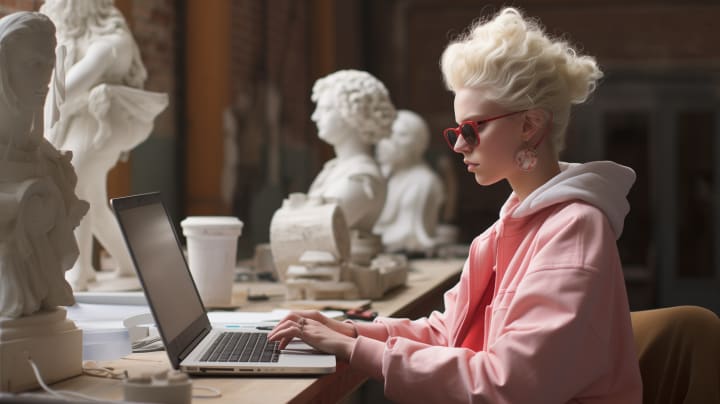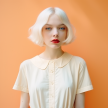Beyond the Binary
Synthography as a New Horizon in Artistic Expression

The digital art revolution has gifted us a novel form of visual creation: synthography. Born from the marriage of advanced algorithms and human imagination, synthography utilizes artificial intelligence to render into being previously inconceivable landscapes, portraits, and abstract visions. However, its nascent presence has sparked a firestorm of debate, with the very question of its legitimacy as an art form fueling endless discourse.
For purists, synthography's automated production process stands in stark contrast to the sweat and skill of traditional artforms. Brushes dipped in physical paint, chisels carving marble – these tangible tools and their embodied mastery form the bedrock of their artistic definition. Synthography, however, replaces them with lines of code and datasets, reducing the artist to a mere prompter, feeding keywords into a digital void.
But such arguments, while sweetly nostalgic, miss the mark. Art has always danced with innovation, reshaping its boundaries alongside technological advancements. Renaissance masters almost univocally imbued their paintings and sculptures with their understandings on mathematics, anatomy and science. Photography later faced accusations of soulless mechanization, only to be embraced as a powerful expression in its own right. The advent of digital tools like Photoshop further blurred the lines between analog and digital creation, pushing the frontiers of artistic possibility.

Synthography, then, represents a natural progression in this ongoing evolution.
Yes, the tools are different, the brushstrokes replaced by pixels conjured through algorithms. Yet, the core of artistic creation – the spark of imagination, the careful orchestration of form and color, the yearning to communicate emotion and elicit thought – remains.
To dismiss synthography based solely on its automated process reveals a narrow understanding of art itself. The artistry lies not in the physical act of creation, but in the vision that guides it, the intention that imbues the final product with meaning. Whether wielded by human hand or coded algorithm, the true power lies in the artist's ability to shape the invisible into something tangible, to make us see the world anew through the lens of their creation.
Professional discourse within the art world reflects this shifting perspective:
Art critic Benji Friedman proposes the term "synthography" itself as a deliberate move away from the sterile label of "AI art." This new framework emphasizes the role of human agency in guiding the AI towards specific aesthetic and conceptual goals. Similarly, scholars like Mario Klingemann analyze the intricate relationship between artist and algorithm, underscoring the collaborative nature of synthographic creation.
Art theorists like Margaret Boden and Terry Smith argue that artistic creation often involves curation and selection as much as raw creation. In the context of synthography, the artist acts as a curator, feeding the AI specific datasets and parameters, then selecting the outputs that best resonate with their artistic vision. This emphasizes the importance of aesthetic judgment and artistic direction even in an AI-driven process.
Theorists like Lev Manovich emphasize the dialogical nature of digital art. In synthography, the artist enters into a dynamic dialogue with the AI, providing prompts and responding to its outputs in an iterative process. This continuous loop of feedback and refinement shapes the final artwork, highlighting the collaborative nature of the creation, with the human agency deciding where the product is "art enough" to stop the algorithmic generation that could very well be infinite if unchecked.
Thinkers like Harold Cohen explore the concept of emergent aesthetics in computer art. Here, the artist sets the initial parameters, but the actual form and characteristics of the artwork emerge through the unpredictable interactions between the artist and the AI, defining a shared authorship where the nature of synthographic creation is unpredictable and often serendipitous.
Finally, consider the broader discussions about the blurring of boundaries between human and machine intelligence. Works by theorists such as Jean Baudrillard and Donna Haraway explore the notion of a posthuman condition, where the distinction between human and machine becomes increasingly difficult to make. In this context, synthography can be seen as a manifestation of this blurring, where artistic creation arises from a complex interplay between human intention and algorithmic processes - the perfect creative brainchild of the Zeitgeist of our time.

Indeed, the question of whether synthography is "real" art becomes irrelevant when faced with the sheer artistic force of the works being produced. Artists like Refik Anadol blend intricate algorithms with human sensitivity to craft immersive, sensory experiences that redefine the boundaries of art installation. Meanwhile, pioneers like Robbie Barrat utilize AI to explore the depths of the human psyche, generating haunting self-portraits that speak volumes about our fragmented digital age.
Moving forward, the focus must shift from sterile debates about legitimacy to an embrace of synthography's unique strengths. Its ability to generate imagery beyond the limits of human imagination expands the canvas of artistic expression. Its reliance on data and code opens doors to new explorations of the relationship between technology and our sense of self. Most importantly, its collaborative nature fosters a dialogue between artist and machine, blurring the lines between creator and created and ushering in a new era of artistic possibility.
Synthography is not a replacement for traditional art, nor is it an inferior imitation. It is a new horizon, a fresh palette of digital dreams waiting to be explored. To cling to outdated definitions is to turn our backs on the boundless potential of this nascent artform.
Instead, let us embrace the symphony of human imagination and algorithmic magic, open our minds to the stories being woven in lines of code, and experience the world anew through the lens of synthography. Only then can we truly appreciate the richness and diversity of the artistic landscape in this age of technological wonder.
About the Creator
Iris Obscura
Artist and writer. Unless observed up close for extended periods and with the right tools, looks perfectly human.
For more, visit my profile on Deviantart: https://www.deviantart.com/irisobscura






Comments
There are no comments for this story
Be the first to respond and start the conversation.